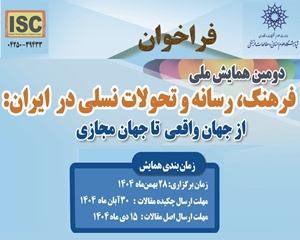ارزیابی میزان رضایت بیمه گذاران از پرداخت خسارت در بیمه های درمان تکمیلی (مقاله علمی وزارت علوم)
درجه علمی: نشریه علمی (وزارت علوم)
آرشیو
چکیده
با توجه به اینکه بیمه های درمان تکمیلی نقش بسزایی در زندگی و سلامت افراد جامعه و همچنین تأمین مالی هزینه های درمانی افراد دارند، از این رو رضایت بیمه گذاران نیز از اهمیت ویژه ای برخوردار است. رضایت بیمه گذاران نشان می دهد که یک شرکت بیمه در زمان صدور بیمه نامه یا پرداخت خسارت، چقدر خدمات و سرویس دهی مناسبی ارائه می دهد. بر این اساس، در این مقاله، به ارزیابی عملکرد پرداخت خسارت در بیمه های درمان تکمیلی پرداخته می شود. روش تحقیق مورد استفاده در این پژوهش، به این صورت است که ابتدا با استفاده از یک مطالعه کتابخانه ای، عوامل مؤثر بر ارزیابی عملکرد پرداخت خسارت احصاء می شود و سپس، عملکرد پرداخت خسارت با استفاده از روش تحقیق کمی و مطالعه میدانی، با ابزار پرسشنامه برای گردآوری داده ها، مورد ارزیابی قرار می گیرد. ساختار پرسشنامه بر مبنای مدل سرکوال و بر اساس پنج بعد فیزیکی، قابلیت اعتماد، پاسخگویی، تضمین و همدلی طراحی شده که انتظارات و ادراکات بیمه گذاران را از عملکرد پرداخت خسارت بررسی می کند. در ادامه، با استفاده از تحلیل عاملی تأییدی، مدل مورد نظر در رضایت بیمه گذار از پرداخت خسارت مورد تأیید قرار گرفت و یافته های تحقیق نشان می دهد بر اساس نمونه جمع آوری شده، نارضایتی مشتریان از کیفیت خدمات خسارت بیمه های درمان تکمیلی در شرکت های بیمه وجود دارد. همچنین این نارضایتی در تمام ابعاد پنج گانه مدل سروکوال یعنی فیزیکی، قابلیت اعتماد، پاسخگویی، تضمین و همدلی نیز وجود دارد. علاوه بر این، ملاحظه می شود که موارد بیشترین انتظارات، کمترین ادراکات را از سوی مشتریان دریافت کرده است و این به نوعی اسباب ایجاد نارضایتی در بین بیمه شدگان را فراهم می کند.Designing the leadership model for knowledge-oriented enterprises
IntroductionDue to the fact that supplementary health insurance plays a significant role in the life and health of people in the society, as well as financing the medical expenses of people, the satisfaction of policyholders becomes very important. The satisfaction of policyholders shows how well an insurance company provides good service when issuing insurance policies or paying claims. Based on this, in this paper, the evaluation of compensation performance in supplementary health insurances is discussed.Methodology The research method used in this research is that first by using a library study, the effective factors on the evaluation of the compensation performance are calculated, and then, the compensation performance is calculated using the qualitative research method and field study, with the questionnaire tool for data collection is evaluated. The structure of the questionnaire was designed based on the SERQUAL model and based on five dimensions: physical, reliability, responsiveness, assurance and empathy, which examines the expectations and expectations of the insurers regarding the compensation performance. The purpose of SERVQUAL model is to evaluate service quality based on customer perception. Customers in the target groups discuss the service quality based on the degree of coordination between the service performance and the expected performance level in different dimensions. High service quality may be provided at a level of performance expected by customers. The level of performance with a high-quality service should provide is the same as the customer's expectations. If the performance is lower than the level of expectations, the quality will be low according to the customers. Service quality in the basic SEVQUAL model of is caused by the gap between expectations and performance. When the performance exceeds the expectations, the quality increases and when the performance is lower than the expectations, the quality decreases. Therefore, the gaps, between expectations and performance in different dimensions that are used to evaluate services, form the theoretical foundations in the SERVQUAL model.Results and Discussion In the following, by using confirmatory factor analysis, the desired model was confirmed in the policyholder's satisfaction with the payment of claims, and the findings of the research show that based on the collected sample, there is customer dissatisfaction with the quality of supplementary health insurance claim services in insurance companies. Conclusion In this paper, several assumptions have been investigated using the SERVQUAL model, and based on the observed samples, the results of their investigation can be expressed as follows. The main hypothesis of the research, that is, "customers were satisfied with the overall quality of supplementary health insurance services", is rejected, in other words, the injured customers were not satisfied with the quality of the evaluation and compensation process services. The first hypothesis, that is, "customers were satisfied with the physical factors in the damage assessment unit of supplementary health insurance" has also been rejected. In other words, customers' satisfaction with physical factors is low and insurance companies have not been able to use modern and appropriate equipment and devices. The second hypothesis, i.e. "customers were satisfied with the reliability of the insurance company in the damage assessment unit of supplementary health insurance" has also been rejected. In other words, insurance companies have not been able to gain the trust of customers. According to the results of the research, the trust between the customers and insurance company has not happened to the customers of supplementary health insurance. The third hypothesis, that is, "customers were satisfied with the level of responsiveness of the insurance company's employees in the claims assessment unit of supplementary health insurance" has also been rejected. In other words, the level of responsiveness of the insurance company's employees in the damage assessment unit could not satisfy the customers. The fourth hypothesis, that is, "customers were satisfied with the insurance company's guarantee in the damage assessment unit of supplementary health insurance" has also been rejected. In other words, the customers were dissatisfied with the insurance company's guarantee, and this issue is definitely very effective in renewing the customer's contract in the future. The fifth hypothesis, that is, "customers were satisfied with the level of empathy of the insurance company's employees in the supplementary health insurance claim assessment unit" has also been rejected. In other words, the employees of the insurance companies have not been able to respect of the customers as they should, and as a result, the customers have not felt a special empathy with the employees of the insurance companies. Regarding the level of expectations and perceptions of customers, the following results can be presented. Three of the highest expectations are related to the reliability dimension. Customers expect ease, speed and transparency in paying their damages. But regarding perceptions, the situation is slightly different. In fact, four of the lowest perceptions are related to the reliability dimension. So, as the items related to the highest expectations have received the lowest perceptions from the customers, this somehow provides reasons for dissatisfaction among the insured








